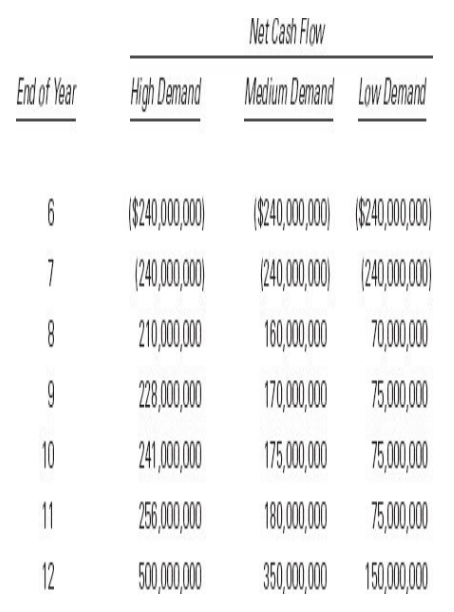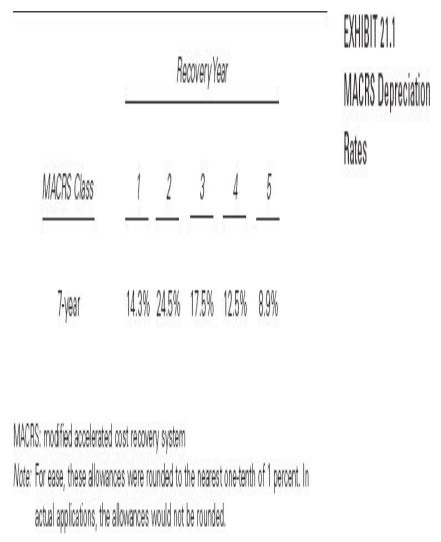Question
NATIONAL REHABILITATION CENTERS (NRC) is one of the nation's leading providers of outpatient rehabilitative medicine. Its board of directors has been considering expanding its service
NATIONAL REHABILITATION CENTERS (NRC) is one of the nation's leading providers of outpatient rehabilitative medicine. Its board of directors has been considering expanding its service line to include sports medicine.
NRC's board is examining two proposals related to the expansion. Proposal A involves a single, large investment that would immediately give the company a national presence in sports medicine. In essence, all of the current rehabilitation facilities deemed suitable to offer sports medicine services would be renovated, equipped, and staffed as required to offer sports medicine services. The amount of capital investment at each earmarked location would vary significantly, but the average cost is estimated at about $800,000 per facility. With roughly 500 locations identified as being suitable for the sports medicine service line, the estimated cost of Proposal A is in the vicinity of $400 million. Although the profitability analysis of Proposal A is only preliminary, its internal rate of return is thought to be in the range of 20 to 25 percent.
Proposal B, on the other hand, involves a more deliberate, two-stage approach to the expansion. Stage 1 of Proposal B calls for a trial program in which only one of NRC's nine regions would offer sports medicine services. If the results of Stage 1 meet the company's profit targets, Stage 2, which calls for the expansion of sports medicine services into the remaining eight regions, would be implemented.
Proposal A requires a much larger capital investment than does Stage 1 of Proposal B. However, overall Proposal B is more costly than Proposal A, even when the time value of money is considered, because Proposal A's large up-front investment leads to greater efficiencies in contracting, construction, recruitment, and marketing. In spite of Proposal A's cost advantage, several board members are concerned about the wisdom of Proposal A because it requires a large investment in a service line that is new to NRC. Other board members, however, see no difference between rehabilitation and sports medicine services; one board member even said, healthcare is healthcare.
The primary task at hand now is to evaluate Proposal B, which includes the trial program and possible expansion into all regions. To date, NRC has spent $7 million to develop a sports medicine concept that matches its approach to rehabilitative medicine. Of the $7 million, $2 million have been expensed for tax purposes, and the remaining $5 million have been capitalized and will be amortized over the five-year operating life of Stage 1. According to a specific Internal Revenue Service ruling requested by NRC, if neither Proposal A nor B is implemented, the $5 million could be immediately expensed. If it decides to go ahead with Stage 1, NRC would immediately spend $2 million to perform local labor-market studies to ensure that the locations identified for the sports medicine program could be staffed. The next step would be to buy the land needed at locations where totally new facilities are required. In total, land acquisition costs, which are assumed to occur at the end of Year 1, are expected to be $10 million. New construction and renovations at the chosen locations would take place during Year 2 and Year 3, and equipment would be installed during the last quarter of Year 3. Additional personnel would be hired as needed at the end of Year 3. The total amount required for new buildings, renovations to existing buildings, and equipment (plus a relatively small amount for recruitment) is estimated to be $50 million. For planning purposes, half of this amount is assumed to be spent at the end of Year 2 and the other half at the end
of Year 3.
Any new buildings would fall into the modified accelerated cost recovery system (MACRS) 39-year tax depreciation class for tax purposes, but (for simplicity) both the buildings and equipment needed are assumed to fall into the MACRS seven-year class. Appropriate depreciation allowances are given in exhibit 21.1. NRC would begin to depreciate the buildings and equipment during Year 4, the year in which the trial sports medicine program would be initiated. The trial program would be evaluated at the beginning of Year 6. If the results are satisfactory, the program would be expanded to the other eight regions. If the program does not meet expectations, it would be terminated at the end of Year 8. If terminated, the land would have an estimated market value of $10 million at that time and the buildings and equipment would have a market value of $30 million. NRC's marketing department has projected two demand scenarios for Stage 1. If demand for the sports medicine program is poor, total revenues are forecasted to be $40 million for Year 4, the first year of operations. However, if demand is good, revenues are expected to be $60 million. At this point, the best
guess is that there is a 50 percent chance of poor demand and a 50 percent chance of good demand. If demand is good, revenues are expected to increase by 6 percent each year after Year 4. If demand is poor, revenue growth is expected to be only 3 percent.
In terms of operating costs, variable costs are expected to be 30 percent of revenues. Fixed costs (other than depreciation), which are expected to total $25 million in Year 4, are forecasted to increase after the initial year of operations at the anticipated overall rate of inflation, 2 percent. If the board approves Stage 2, NRC would spend an additional $480 million on land, buildings, and equipment to expand into the other eight regions. This expenditure would be evenly split between Year 6 and Year 7. As shown in the following table, the net cash inflows forecasted for Stage 2 depend on the demand scenario:
Note that the net cash flows have been bumped up in Year 9 to reflect the cash flows from those facilities in the test region. In addition, note that the project is expected to last beyond Year 12, and an allowance for the value of these future cash flows is embedded in the Year 12 cash flows. The estimated probabilities of the Stage 2 demand scenarios are related to the response to the Stage 1 trial program. If acceptance is poor in Stage 1, there is a 10 percent probability that demand will be high during Stage 2, a 40 percent probability that demand will be medium, and a 50 percent probability that demand will be low. However, if acceptance during Stage 1 is good, there is a 50 percent probability that demand will be high during Stage 2, a 40 percent probability that demand will be medium, and a 10 percent probability that demand will be low. Of course, these expectations may change over time as new information becomes available. Furthermore, the actual demand scenario for Stage 2 is not expected to be known until midway through Year 8, after the program has been operational nationally for six months. NRC's current effective income tax rate is 30 percent, and this rate is projected to remain roughly constant into the future. The firm's corporate cost of capital is 10.0 percent, and NRC changes this amount up or down by 3 percentage points to adjust for project risk. NRC defines low-risk projects as those that have a coefficient of variation (CV) of net present value of less than 0.8, average-risk projects as those that have CVs in the range of 0.8 to 1.2, and high-risk projects as those that have CVs of more than 1.2.
One of the most important advantages of staged entry is that new information will become available throughout the investment period. NRC's managers recognize the value of this feature and believe that they will have a better estimate of the Stage 2 probabilities and cash flows before making the Year 6 investment. Even if Stage 2 is undertaken, there is some possibility that the project could be abandoned at the end of Year 8 if the low-demand scenario materializes. If the project is terminated at that point, the best estimate for the Year 8 abandonment cash flow is $420 million. The uncertainty of whether abandonment would occur lies more in the politics than in the economics of the decision. In the past, NRC's managers have not been inclined to admit mistakes
and cut losses, so some doubt lingers about whether the abandonment decision would be made even if it is the financially right thing to do at the time.
You have been hired as a consultant to analyze the sports medicine program and to make a recommendation to NRC's board of directors regarding the best course of action. In addition to a detailed analysis of Proposal B, you have been asked to subjectively compare the relative merits of Proposal A with those of Proposal B.


i) Describe the advantages and disadvantages of Proposal A (single, large investment) versus Proposal B (staged entry). Based on the limited amount of information available, what do you think the company should do? Carefully justify your final recommendations. j) In your opinion, what are three key learning points from this case?
Step by Step Solution
There are 3 Steps involved in it
Step: 1

Get Instant Access to Expert-Tailored Solutions
See step-by-step solutions with expert insights and AI powered tools for academic success
Step: 2

Step: 3

Ace Your Homework with AI
Get the answers you need in no time with our AI-driven, step-by-step assistance
Get Started


